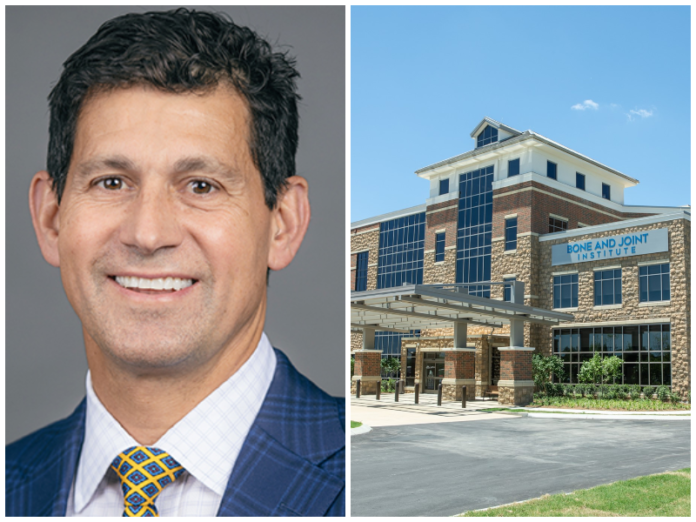You don’t have to be a professional athlete to benefit from the innovative field of sports medicine. We recently caught up with Christopher Stark, M.D., who brought us up to speed on total shoulder replacement late last year, to find out what’s new in sports medicine.
In addition to treating patients of all ages at the Bone and Joint Institute of Tennessee, Dr. Stark and colleagues care for middle and high school sports teams throughout Williamson County as designated providers.
Williamson Source: Where did your interest in sports medicine begin?
Dr. Stark:
I played sports, including four years of college lacrosse, and managed to have several injuries. I was also a ski patrol for about seven years out West during high school and college and cared for a range of traumatic injuries and sports injuries, such as ACL tears and shoulder injuries. I would take my patients down the hill and work with the orthopaedist down there. So, my interest comes by a combination of my personal sports interests and exposures.
WS: What types of patients see you for sports medicine care at the Bone and Joint Institute of Tennessee?
Dr. Stark:
We treat young kids all the way up to elderly patients who are very active. I’ll see 70-year-olds who are into weightlifting or tennis, and we’ll do a surgical repair, which is considered as sports medicine. The goal is to get patients back to activity, so we treat everything from the foot to the shoulder.
WS: In what circumstances should a patient see a sports medicine physician rather than their primary care provider?
Dr. Stark:
When something is serious – difficulty ambulating, for example – you’re probably better off seeing an orthopaedist with an interest in sports. If it’s just a nagging or mild injury, you might go to your primary care provider. It’s also okay to go directly to a therapist for a mild injury, such as a knee symptom from running. If an injury is really hurting a lot and you don’t improve with therapy after four or five visits, go to the sports medicine doctor.
WS: How can athletes prevent injury from occurring in the first place?
Dr. Stark:
Strength-training smaller muscles that aren’t as frequently worked is important. If you run, you may not use your glutes and abductors much, for example, but you still need to strength-train those muscles. In most kids or adults, cross-training makes a big difference; take a break, do other sports, and use other muscles. The 60-year-old runner also needs to get on a bike or elliptical to use other muscles.
Flexibility and some light stretching is important. There’s not a lot of data on flexibility and stretching for injury prevention, but we believe it helps.
Rest makes a significant difference, as well. Breaks from the routine are important. Lastly, come see us or the therapist before it gets bad. We often see the athlete early in the season after they’ve been dealing with issues for several months and we have to pull them off for the early season. It’s better if the athlete comes to see us in the off-season.
WS: What new and innovative sports medicine treatments are being used at the Bone and Joint Institute of Tennessee?
Dr. Stark:
The changes are happening so fast. Some are technical – like the way we do ACL repairs now with the all-inside technique. This results in less recovery time and a better graft.
We are also looking at how abnormal motion leads to injury. We use sensors that provide feedback on abnormalities in the hip and knee in real-time. The idea is to use this technology to teach patients how to improve their motion.
And, of course, we are well known for robotic- and navigation-assisted procedures.
WS: What are some of the benefits of receiving sports medicine care from the Bone and Joint Institute of Tennessee in particular?
Dr. Stark:
We have a group of doctors who keep up on the forefront of ideas in sports medicine and really challenge themselves. There are about seven or eight of us who, with our therapists, challenge ourselves to keep pushing for better outcomes. There’s a lot of collaboration with new ideas through meetings and readings and working together – all with the goal of the best care and quick recovery.
We also have a state-of-the-art surgical facility here in our building, should an injury come to that. As a group, we do more non-invasive techniques for treating injury, from cold therapy to biologics (injectables). Therapy makes all the difference for the patient, as well, and having that in-house is a big benefit. We’re always going to go the extra mile.
We are also unique compared to many other practices in that we look at compounding factors. If someone comes in with knee pain and they’re a runner, we’re going to look at the whole athlete and find if there are related issues in the hip or ankle, for example.
Our practice, in partnership with Williamson Medical Center, is also the official sports medicine provider for the Williamson County Schools.
Sports Medicine at The Bone and Joint Institute
For more information about sports medicine services, contact Christopher Stark, M.D. at The Bone and Joint Institute of Tennessee. Call (615) 791-2630. You can also schedule an appointment online.
Have a question for the Bone and Joint Institute? Fill out the form below:
Please join our FREE Newsletter



















